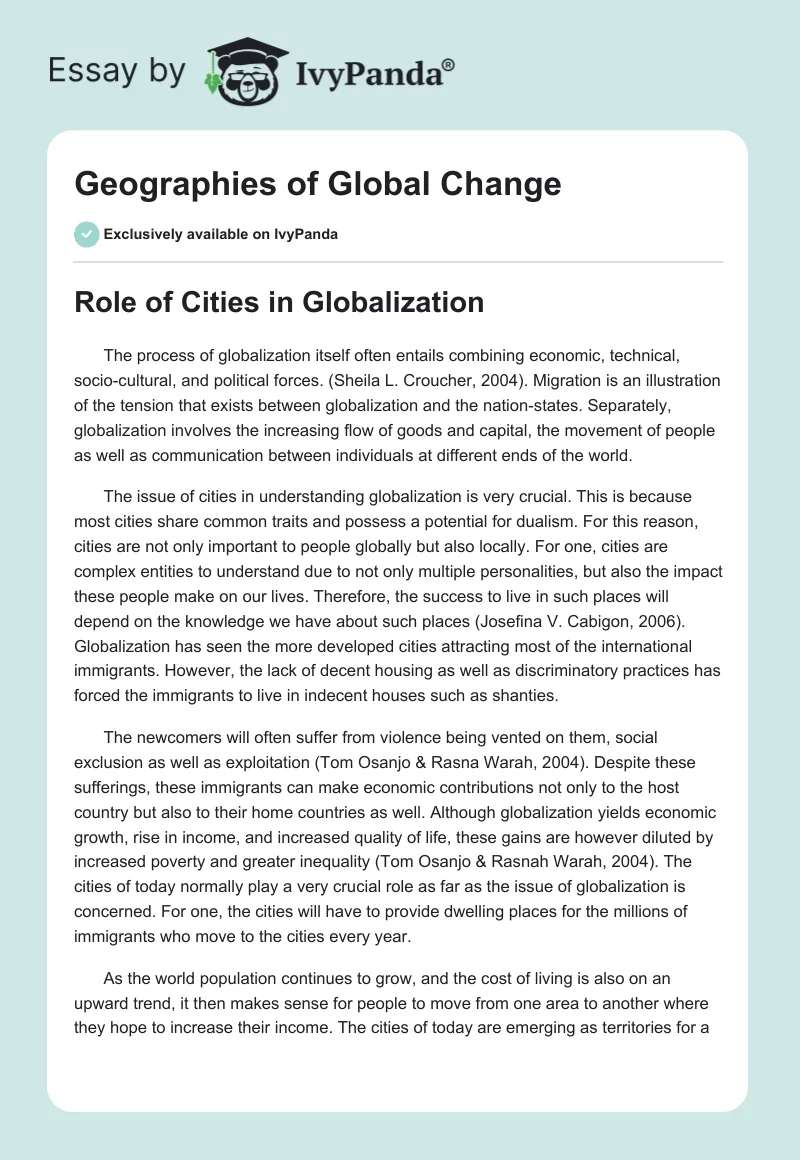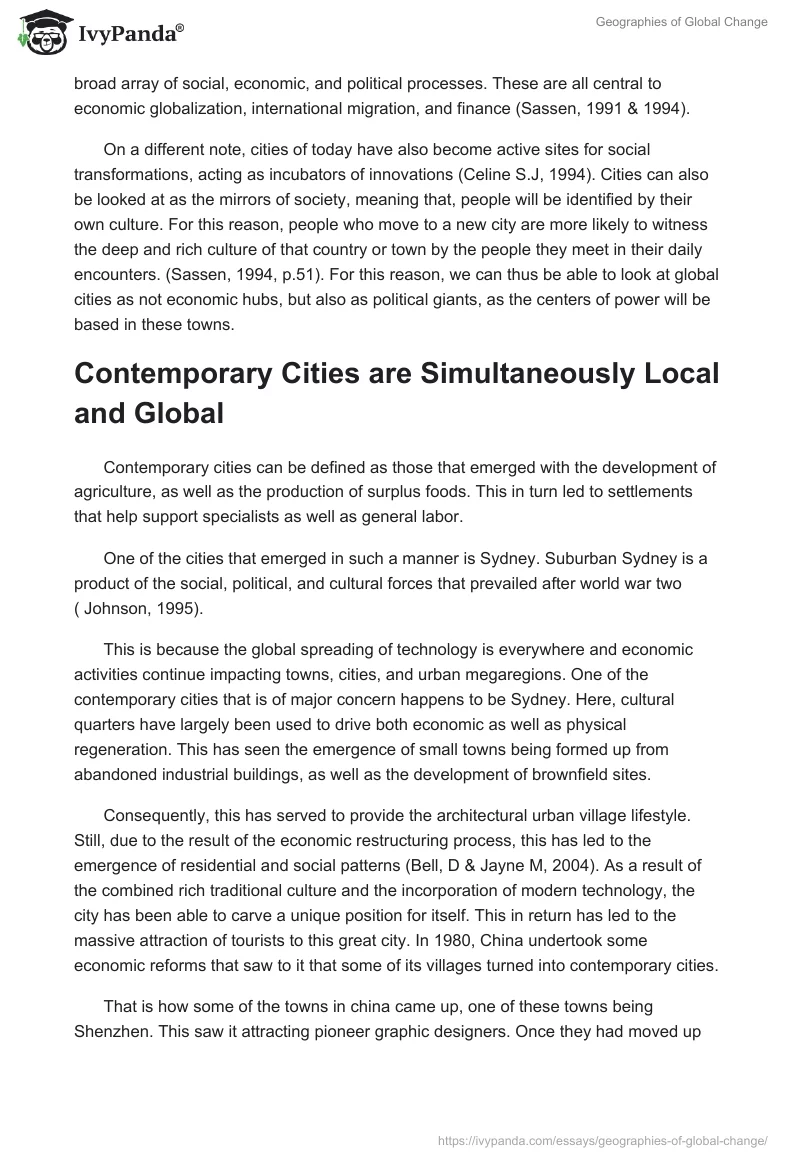Role of Cities in Globalization
The process of globalization itself often entails combining economic, technical, socio-cultural, and political forces. (Sheila L. Croucher, 2004). Migration is an illustration of the tension that exists between globalization and the nation-states. Separately, globalization involves the increasing flow of goods and capital, the movement of people as well as communication between individuals at different ends of the world.
The issue of cities in understanding globalization is very crucial. This is because most cities share common traits and possess a potential for dualism. For this reason, cities are not only important to people globally but also locally. For one, cities are complex entities to understand due to not only multiple personalities, but also the impact these people make on our lives. Therefore, the success to live in such places will depend on the knowledge we have about such places (Josefina V. Cabigon, 2006). Globalization has seen the more developed cities attracting most of the international immigrants. However, the lack of decent housing as well as discriminatory practices has forced the immigrants to live in indecent houses such as shanties.
The newcomers will often suffer from violence being vented on them, social exclusion as well as exploitation (Tom Osanjo & Rasna Warah, 2004). Despite these sufferings, these immigrants can make economic contributions not only to the host country but also to their home countries as well. Although globalization yields economic growth, rise in income, and increased quality of life, these gains are however diluted by increased poverty and greater inequality (Tom Osanjo & Rasnah Warah, 2004). The cities of today normally play a very crucial role as far as the issue of globalization is concerned. For one, the cities will have to provide dwelling places for the millions of immigrants who move to the cities every year.
As the world population continues to grow, and the cost of living is also on an upward trend, it then makes sense for people to move from one area to another where they hope to increase their income. The cities of today are emerging as territories for a broad array of social, economic, and political processes. These are all central to economic globalization, international migration, and finance (Sassen, 1991 & 1994).
On a different note, cities of today have also become active sites for social transformations, acting as incubators of innovations (Celine S.J, 1994). Cities can also be looked at as the mirrors of society, meaning that, people will be identified by their own culture. For this reason, people who move to a new city are more likely to witness the deep and rich culture of that country or town by the people they meet in their daily encounters. (Sassen, 1994, p.51). For this reason, we can thus be able to look at global cities as not economic hubs, but also as political giants, as the centers of power will be based in these towns.
Contemporary Cities are Simultaneously Local and Global
Contemporary cities can be defined as those that emerged with the development of agriculture, as well as the production of surplus foods. This in turn led to settlements that help support specialists as well as general labor.
One of the cities that emerged in such a manner is Sydney. Suburban Sydney is a product of the social, political, and cultural forces that prevailed after world war two ( Johnson, 1995).
This is because the global spreading of technology is everywhere and economic activities continue impacting towns, cities, and urban megaregions. One of the contemporary cities that is of major concern happens to be Sydney. Here, cultural quarters have largely been used to drive both economic as well as physical regeneration. This has seen the emergence of small towns being formed up from abandoned industrial buildings, as well as the development of brownfield sites.
Consequently, this has served to provide the architectural urban village lifestyle. Still, due to the result of the economic restructuring process, this has led to the emergence of residential and social patterns (Bell, D & Jayne M, 2004). As a result of the combined rich traditional culture and the incorporation of modern technology, the city has been able to carve a unique position for itself. This in return has led to the massive attraction of tourists to this great city. In 1980, China undertook some economic reforms that saw to it that some of its villages turned into contemporary cities.
That is how some of the towns in china came up, one of these towns being Shenzhen. This saw it attracting pioneer graphic designers. Once they had moved up here, they were able to establish graphic industries, and this in turn led to the migration of artists.
At the Dresden palace, for example, there are traces of virtually every style period of European architecture. Another contemporary fame here is the Baroque buildings. Although the town has undergone a major metamorphosis since the time of Augustus the Strong, there are still today traces of the gone era. These are well represented by the Blochhaus, the Taschenberg Palais, and George Bahr’s Frauenkirche church among others.
Global, National and Local Factors that have shaped the European Welfare State since 1980
Through the 1980s and 1990s, strides towards developing the transition economies have led to the emergence of openness to trade. This has seen extensive growth in trade, and as a result, a new global division of labor in the production of goods has emerged. (David Held et al, 1999). Clearly, fiscal pressures on the welfare state and increased unemployment in Europe have occurred simultaneously with the changes in the international economy, generally subsumed under the label of globalization. The flow of goods, especially capital across borders have increased, as have the reach of transnational corporations. Also, the production networks based on subcontracting arrangements have increased. (Mauro Guille’n, 1999).
Although globalization is often seen as a good thing, it, however, led to the Western European crisis in the 1990s. The globalization of markets seemed to leave the government with no choice but to pursue neo-liberal policies. ( Garret 1998 b: 2). In terms of the domestic factors, the widening gap between a high rate of productivity, improvements in industrial manufacturing as well as increasing demand for manufactured goods comes into play. It has also been revealed that the technological innovation and the changing consumption patterns rather than the international market integration drive are what drives the transformation process (Iversen and Wren, 1998). Political developments over the years have played a major part in shaping up the welfare states of Europe. Through globalization, there has been a phenomenal increase in world trade.
The same can also be said about the trade’s alleged effects on both governments and corporations. There is however little evidence that world trade has reduced the ability of the governments to intervene in their economies, as well as engage in welfare activities. Indeed, it appears that in the areas whereby trade has expanded, social protection has expanded as well (Rodrik, 1999). Other factors that have helped shape welfares in Europe would include the nature of the class mobilization, class-political coalition structures, and the historical legacy of regime institutionalization. (Esping- Anderson, 1990).
The historical legacies of liberal, conservative, and social principles have become institutionalized and perpetuated in their respective welfare-state regimes over time (Esping-Andersen, 1990). As unemployment rises, there is the need for the government to establish welfare societies to address the needs of these unemployed people. Thus, it has indeed helped to shape up the welfare societies. Unemployment in the 1980s was chiefly due to the recession period that was being experienced then. This was all a consequence of globalization, and so we can be able to say that the rise of welfares was triggered by globalization.
Gender equality has also affected welfare societies. This is because of the need to have equal working conditions for both men and women. Internal factors such as the state, industry, labor, have also played their part in affecting the issue of welfares. (Andersen, 2002 a). However, these factors have also been pushed forward by external factors such as globalization, and Europeanization. (Everlyn Huber& John D. Stephens, 1999).
Works Cited
David Bell & Mark Jayne., Urban Villages in the Contemporary City, Aldershot, 2004, 287.
Josefina V. Cabigon, (2006): Cities in globalisation, College of Social Sciences & Philosophy.
Tom Osanjo & Rasna Warah, (2004). The States of The Worlds Cities: Global & Urban Culture, Earthscan, ISBN 1-84407-160-X.
www.world66.com
www.urban.aau.dk
www.vam.ac.uk




